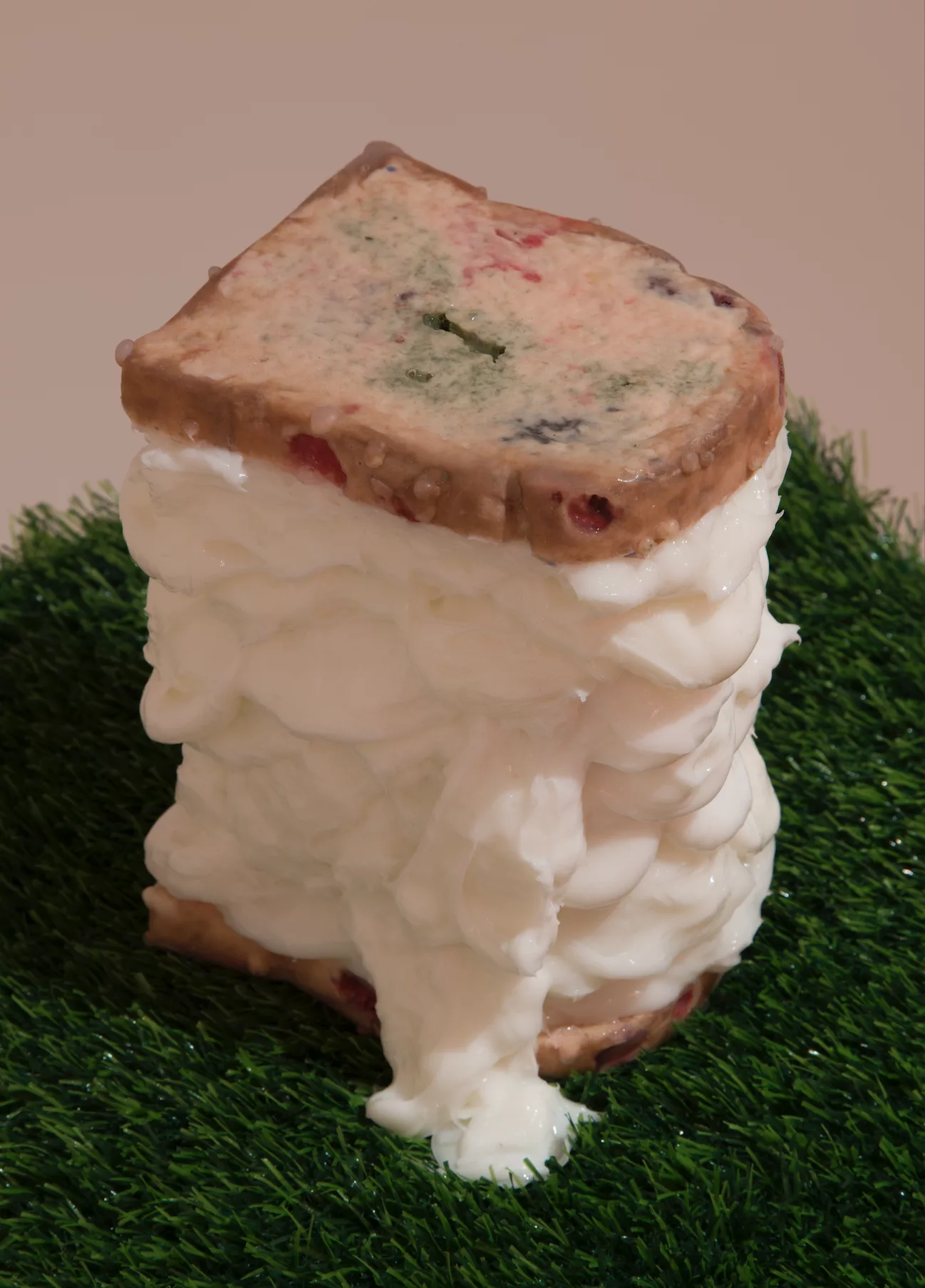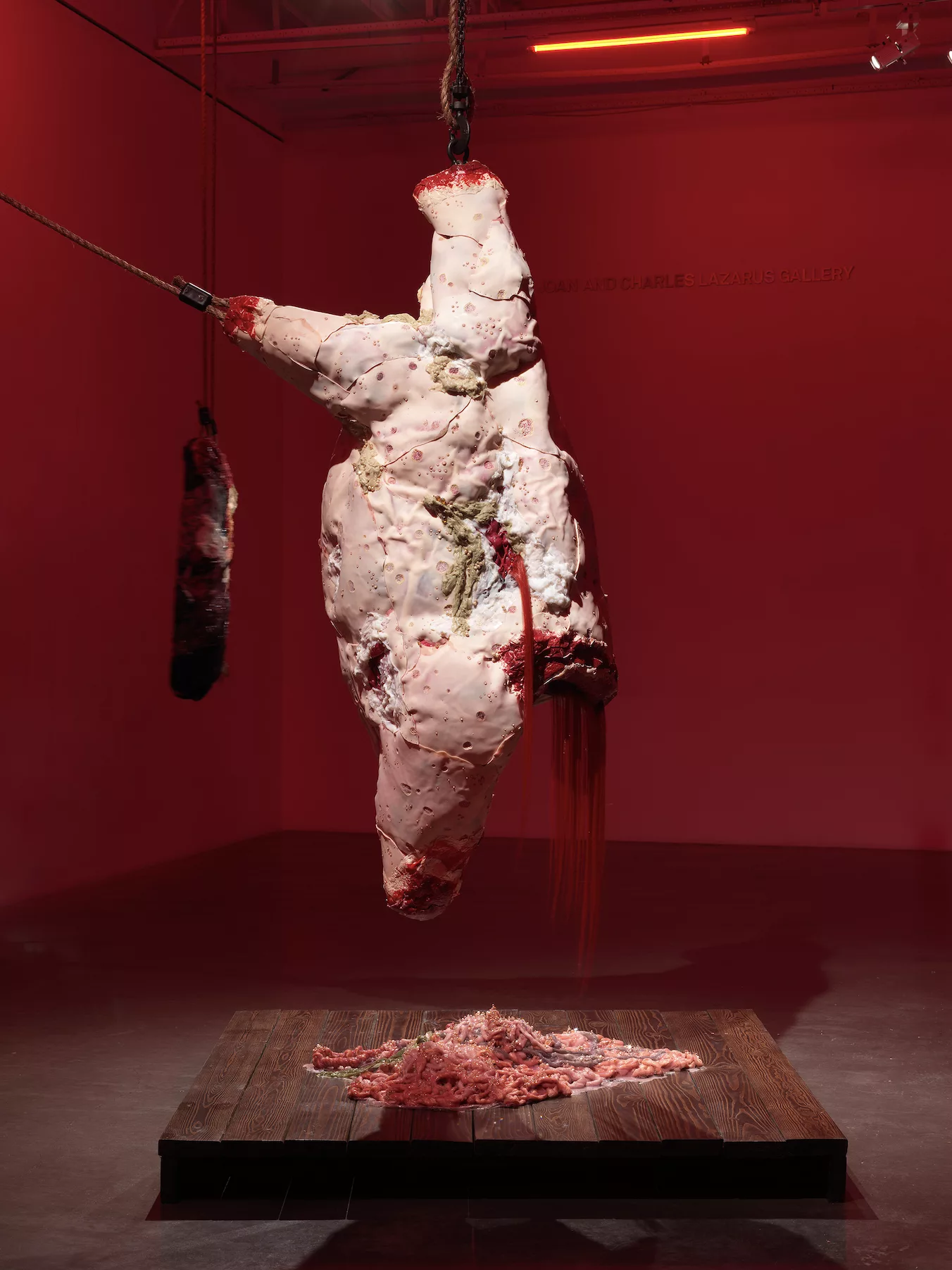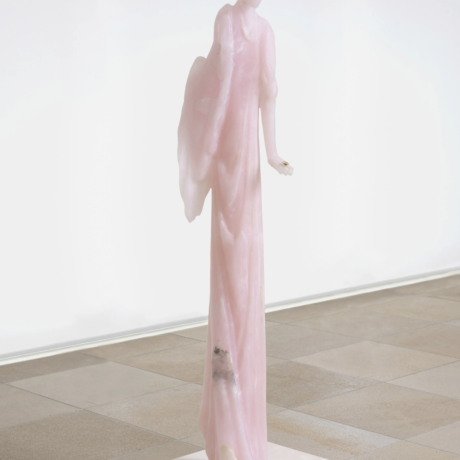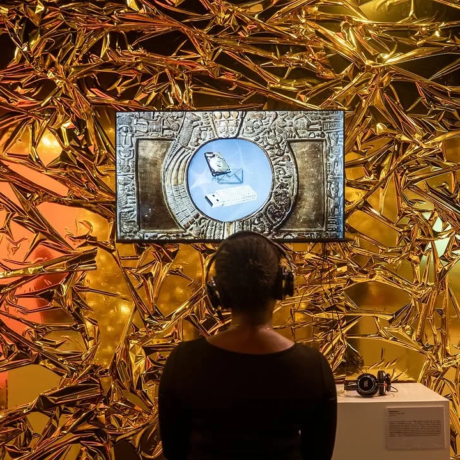
King Cobra, previously documented as Doreen Lynette Garner, is not one to forget History. The Brooklyn-born artist questions the neutrality associated with whiteness, converting its presence into an unignorable echo from the past. Her work articulates historical vestiges that underpin the operations of our art, culture, politics and society, invariably appearing in the form of renewed violence today. Using the corporeal as her predominant medium, Cobra incorporates a mixture of materials that articulate the ancestorial violence committed towards Africans during the transatlantic slave trade, where many were the victims of medical abuse. Cobra intertwines their narratives and names in her works. One instance is her reference to Joice Heath, whose remains were cut open in New York’s City Saloon in front of 1,500 paying spectators in 1836. In response to this, Cobra entitled a 2020 work As the gauze in my mouth filled with blood and my limp body hit the concrete, I remembered Joice Heth.
White flesh has an uncanny presence in Cobra’s sculpture, which speaks to the lineage of white bodies being associated with neutrality, a luxury only available to the privileged few, and often synonymous with indifference. In her website Filthy Dreams, Emily Colucci writes that “Cobra not only refuses whiteness as neutral, but she also digs deep into its abjection.” Cobra’s work has also been cited as echoing the sentiment of an essay written by Miguel Gutierrez in 2018 entitled ‘Does Abstraction Belong to White People?’,where he answers the question, “Who has the right not to explain themselves?’ with the reply, “The people who don’t have to. The ones whose subjectivities have been naturalized.” Cobra’s work poises itself in the post-naturalisation era, producing a postcolonial narration that surveys whiteness with a sneer.


Lucy Broome: Can you talk about what inspired ‘King Cobra?’ Would you consider it a title, a name, an alter ego?
King Cobra: It’s my name. It’s what I’ve been going by for almost two years now. I decided to change my name after some of the messages I received during visualisation and meditation. Looking into the spiritual properties of the cobra, I found that it’s known to be reflective and observant but also protective of its family and loved ones. It should be approached with respect and caution. My name primes people to understand how to approach me.
LB: I saw that you incorporated reiki healing from your colleague Master Hue in your panel discussion Black Dykes Contemplating Carnage with Vivian Crockett at the New Museum. What roles do ritual and spirituality play in your work?
KC: Spirituality and ritual definitely play a huge role in my life in general. Even as a child, I was drawn towards rites of passage and the rituals of body modification. Lengthy and or painful experiences bring forth spiritual awakening and enlightenment. I get ideas about sculptures during many of my meditations. I often end up collaborating with God, my ancestors and my spirit guides on works that should be brought to life in this realm right now. It’s been a culmination of all my interests, including flesh, blood and bodily fluids.
LB: In other interviews, you’ve spoken about your transition from working with black skin tones to white skin tones, which happened post-pandemic, and was reactive to frequent instances of the torture of Black people being broadcast world-wide. Have you noticed a difference in how your work has been received since this shift?
KC: I think so. It’s always a question about the collector and what people want to live with physically, spiritually, intellectually and emotionally. Back when I was creating work that focused on the exploitation of Black bodies, regretfully it seemed like Black trauma was more saleable than my works where the criticism of whiteness is apparent. It doesn’t make sense to me because there are so many white artists who make work about existentialism, disease and the body being like a grotesque fragile vessel. Their work is widely accepted and celebrated across the world and it’s frustrating. For me, it transformed into an effort to expose hypocrisy and firmly critique the negligence in addressing the issues of race in those works, especially because they centre whiteness.
“Whiteness should be dissected with diligence. Whiteness is not a neutral representation of humanity.“
LB: What was the effect on your experience of producing the work after you made the transition?
KC: I had a lot more fun making work, mostly because I didn’t have the emotional responsibility of treating the silicone with care. Because it no longer looked like me, or reflected my skin tone, I was able to have a little bit more freedom in cutting and stitching and applying mysterious goo. So, in that way, it felt really fun. It also felt accurate to history, especially referencing a lot of the diseases that were spread by Europeans to Black and Indigenous communities via the transatlantic slave trade and colonisation voyages. I didn’t feel like I was exaggerating these depictions because my renderings were comparable to evidence in collections in many medical museums.
LB: I saw your sculpture Feast of the Hogs (2022) at the Hardcore group show at Sadie Coles HQ. I was really drawn to the way you used mixed materials. There are glass beads and hair where the rib cage would be. Are there any particular implications of using this mix of materials?
KC: At first, I had no idea how I was going to depict the hog. A lot of times I find my materials in obscure places that you wouldn’t necessarily think of for sculpture. I spend a lot of time at the beauty supply, fancy-dress shops or bead stores. Sometimes I go to baking depots and find strange silicone moulds that look like assholes or vaginal openings. When those things are put together en masse, they take on a totally different texture. So when I was thinking about the ribcage, I was just starting to mess around with some things. I casually coated the blond hair weave with silicone and started pinning things together. My studio is a total mess. I’m absolutely guilty of being a hoarder. So a lot of times, I see materials from older sculptures and figure out ways to include them in the new sculpture. The blond hair was really important in the Feast of the Hogs, as well as some of the white-woman cameos, which are a dusty, fleshy rose and bone colour. When placed side by side, the cameos just look like another crusty part of the pig.
LB: What drew you to working with the corporeal and flesh?
KC: I could try to think of a concrete reason, but it’s kind of just been in me from the beginning. When my sister had her stroke, we spent a lot of time in the hospital. I would see a lot of kids who had survived car injuries and had their legs in braces, or sustained severe burns. I think being in that environment made me very aware of the fragility of the body, but also interested in figuring out ways to depict that or illustrate a lot of textures I remember seeing.
LB: Feast of the Hogs reminded me of another piece of yours: The Pale One (2020). While Feast of the Hogs, is clearly referencing a pig’s carcass, The Pale One is more ominous. It has an opening on one side reminiscent of a shark’s mouth, but the overall shape isn’t as clear cut. Was its form meant to reference anything directly?
KC: I guess it could look mysterious from the front, but I feel it’s obvious from the profile/side view that it’s a pale horse head that’s chopped off at the neck. From the front, the neck turns into a dragon’s mouth. There are definitely a lot of biblical references, especially from Revelations, thinking about the pale horse and its rider being able to kill off a quarter of the earth’s population. That piece was created as we were coming out of lockdown. I was thinking a lot about plagues, diseases and even biological warfare. The horse head is rotting, because it represents disease and decay. I understand that that could be understood as being abstract, but in my mind, it seems so clear.
LB: It also speaks to Roughly Documented, Three Million Eight Hundred Ninety-Four Thousand and Fifty-Six (2021), a piece that used silicone to represent diseased white flesh in the shape of Portuguese and British flags, with Black body parts on the back side reflected in a mirror. What is the role of mirrors in your work?
KC: I use mirrors pretty often to show the backs of sculptures. I’m a very investigative viewer, and I like to look for a sculptor’s mistakes or the angles of sculptures that they forgot or didn’t think that people would look at. So I like to leave surprises for people when they’re looking at my work, or new things that they can discover every time they visit the work. It was really important for me to activate the back of the flag in those works. They were made for a show in Austria [Steal, Kill and Destroy: A Thief Who Intended Maximum Harm (2021)], so I wanted the first thing you encounter with those works to be diseased white flesh. Upon further investigation, you see the bodies of people that were affected by those diseases. That was my first attempt at rendering diseased white flesh in silicone and the first time I had tattooed silicone. It was the very beginning of this new body of work where I’m merging both of my practices, one as a sculptor and the other as a body modifier, to be more effective in the depiction of skin.
LB: White Bread (2021) refers directly to a ‘consumable’ object. Was there a reason why you created something that appeared more edible?
KC: I was just thinking about whiteness in general, and some of the things that you associate with whiteness, whether it’s an object, or whether it’s a dish or a type of clothing—anything like that. I was thinking about the plainest things or the most flavourless things, and white bread was at the top of my mind. I liked the absurdity of making a diseased loaf of white bread and chopping up, so it also looked really disgusting on the inside. Although it does look really disgusting, it also deeply resembles a lot of European foods!

LB: It is quite reminiscent of spam, or a meatloaf stuffed with an egg. Also, the proximity of hair to flesh, can be read as a perversion or fetish. Did the context of the Sadie Coles show, and the theme ‘hardcore’, the main element of which is obviously sexual, provide a different reading of your work?
KC: When you’re talking about perversion, there’s an element of BDSM culture that does involve cutting, binding restraint and sometimes even blood play. There are some elements apparent in those works. This is especially true for Feast of the Hogs because it’s bound and hung from the ceiling.
LB: Have you ever thought about the way in which your works will decay, given that they’re silicone? Will they ever?

KC: Absolutely, but I’m doing the best I can in terms of longevity. The guarantee is at least 50 years, depending on how people take care of the work. I have a lot of hope for them. In comparison to some of the sculptors I admire, but whose works haven’t held up, I’m definitely being very thoughtful about the hardware that I use and the pressure that I put on certain silicones with different tear strengths, and I’m also introducing Plexiglass, or using a more dominant material for the overall sculpture.
LB: Is there anything you feel you’re yet to address in your work that you’re looking to do next?
KC: Yes, I think that’s why I’m moving towards video and film. I’m interested in expanding my audience and reconsidering my role as a sculptor who makes physical objects requiring physical presence. Using this new medium is going to open up a lot of opportunities for things to be edited in post and allows objects to be unfinished. There’s a lot of potential for breakthroughs to happen in ways that I’ve fully exhausted as a material sculptor. I’m interested in doing feature films, short films, dialogue, maybe even directing some strange porn. Those are some of the ways my sculptures can be reactivated.
Written by Lucy Broome





